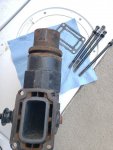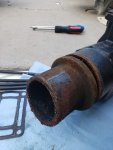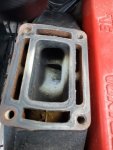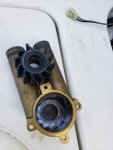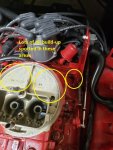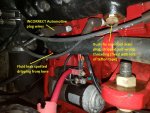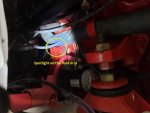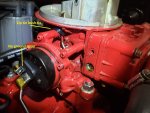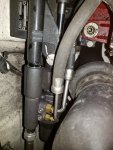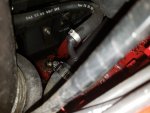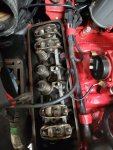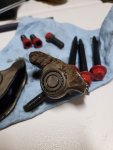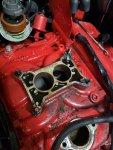All, first time post, and looking for a little advice. I bought a 2003 Four Winns 180 horizon with a 4.3GL-C. it runs good except at WOT, when it sounded like it was spitting. At the end of last season, it was leaking quite a bit of oil from several locations, and I suspected blowby among other things (possibly a blown head gasket).
So, I checked the compression this month, and cinder 4 (center cylinder on starboard) is only at 75psi dry and 90psi wet. All other cylinders are at 125-130. With that being said, I already assume I'm buying a long block (assuming rings are bad), so I'm trying to determine what else needs to be replaced.
I decided to remove the starboard riser because the gasket was showing some minor signs of rust leaks. Well, the
riser internals and the manifold ports all look OK to me, but I'm not sure what I'm looking at. The outside of the riser that inserts in the exhaust tube is rusting. Do you think this needs to be replaced?
While the riser was off, I took a look into the manifold at the exhaust port of cylinder 4. Seems to be a bit more carbon build up there, but I would love to know if you see something more than me:.
Also, the when I took the impeller out, it seemed to have a sheen of oil inside. Any clues?
A little more background info: I have no reason to doubt that just about everything is orignal to the boat. These are likely 2003 headers and risers, although the manifolds look to come from a 4.3GL-P rather than a 4.3GL-C (which is the sticker on my motor). I can tell this because of the location of the drain port. The previous owner(s) have done some bush-fixes in the past, like shoving a wrong sized bolt into the drain hole. The belts look to be vintage 2003 as well, so I believe only the bare essentials were ever done to this boat.
So, I checked the compression this month, and cinder 4 (center cylinder on starboard) is only at 75psi dry and 90psi wet. All other cylinders are at 125-130. With that being said, I already assume I'm buying a long block (assuming rings are bad), so I'm trying to determine what else needs to be replaced.
I decided to remove the starboard riser because the gasket was showing some minor signs of rust leaks. Well, the
riser internals and the manifold ports all look OK to me, but I'm not sure what I'm looking at. The outside of the riser that inserts in the exhaust tube is rusting. Do you think this needs to be replaced?
While the riser was off, I took a look into the manifold at the exhaust port of cylinder 4. Seems to be a bit more carbon build up there, but I would love to know if you see something more than me:.
Also, the when I took the impeller out, it seemed to have a sheen of oil inside. Any clues?
A little more background info: I have no reason to doubt that just about everything is orignal to the boat. These are likely 2003 headers and risers, although the manifolds look to come from a 4.3GL-P rather than a 4.3GL-C (which is the sticker on my motor). I can tell this because of the location of the drain port. The previous owner(s) have done some bush-fixes in the past, like shoving a wrong sized bolt into the drain hole. The belts look to be vintage 2003 as well, so I believe only the bare essentials were ever done to this boat.




















